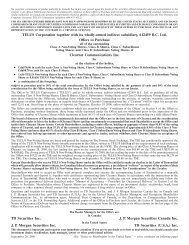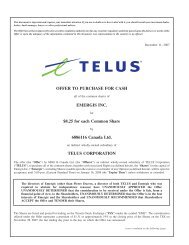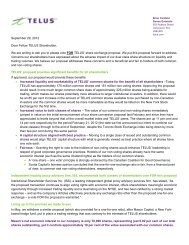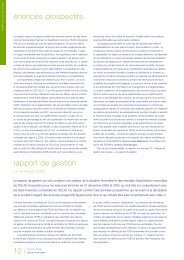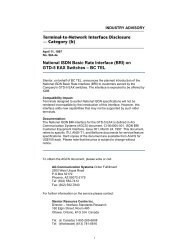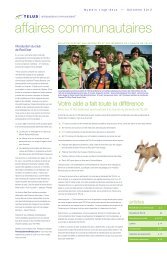Annual report - About TELUS
Annual report - About TELUS
Annual report - About TELUS
Create successful ePaper yourself
Turn your PDF publications into a flip-book with our unique Google optimized e-Paper software.
management discussion and analysis<br />
Technological Change<br />
Changing technology in data, IP and wireless may adversely<br />
affect revenues, costs and value of assets<br />
The pace and the scope of technological advancements<br />
in the communications industry are expected to continue<br />
to accelerate in the foreseeable future. Two of the universal<br />
characteristics of technological advancements are<br />
lower unit costs and increasing flexibility. This creates<br />
opportunities for new and existing competitors to offer<br />
price reductions and service differentiation to gain market<br />
share. <strong>TELUS</strong>’ future success will be dependent upon its<br />
ability to anticipate, invest in and implement new technologies<br />
with the levels of service and prices that its customers<br />
require. <strong>TELUS</strong> may be required to make more<br />
capital expenditures than are currently expected if a technology’s<br />
performance falls short of expectations and<br />
<strong>TELUS</strong>’ earnings may also be affected if technological<br />
advances shorten the useful life of some of its assets.<br />
The digital protocols utilized by <strong>TELUS</strong> may become<br />
technologically inferior which could adversely affect <strong>TELUS</strong><br />
The wireless industry is in the process of adopting second<br />
(2.5G) and third generation (3G) technologies that are<br />
expected to deliver increased data speeds required to<br />
deliver many new wireless IP and data services. Various<br />
operators are announcing capital cost plans to permit<br />
existing wireless protocols to migrate to 2.5G in 2001<br />
and 3G subsequently over the next two to three years.<br />
While we believe <strong>TELUS</strong> Mobility’s CDMA protocol has a<br />
reasonable and cost effective migration path to 2.5G and<br />
3G, there can be no assurance that it will be successful<br />
and timely. <strong>TELUS</strong> will continue to assess this issue during<br />
the year. In addition, the <strong>TELUS</strong> Mike service uses an<br />
iDEN technology protocol which already has packet capability<br />
and service offerings in contrast to competitive protocols;<br />
however, it has not yet been fully determined how<br />
it will migrate to 3G.<br />
> 58<br />
Regulatory<br />
Regulatory developments could have an adverse impact on<br />
<strong>TELUS</strong>’ operating procedures, costs and revenues<br />
<strong>TELUS</strong>’ telecommunications services are regulated<br />
under federal legislation through the CRTC. The CRTC<br />
has taken steps to forbear from regulating prices for<br />
certain services such as long distance and some data<br />
services and does not regulate the pricing of wireless<br />
services. Major areas of regulatory review currently<br />
include the contribution payment regime, price cap<br />
regulation of local telephone rates and access issues<br />
with cities and building owners.<br />
The outcome of the regulatory proceedings and court<br />
appeals discussed below and other regulatory developments<br />
could have an impact on <strong>TELUS</strong>’ operating procedures,<br />
costs and revenues. There can be no assurance<br />
that these regulatory outcomes will not be materially<br />
adverse to <strong>TELUS</strong>.<br />
Contribution payment calculation modified by CRTC<br />
The CRTC requires <strong>TELUS</strong> and other regional telephone<br />
companies to provide basic residential services at belowcost<br />
rates in high cost serving areas (e.g., rural areas).<br />
In a recent decision, effective January 1, 2001, the CRTC<br />
expanded the application of contribution charges that<br />
provided for a partial subsidy to high cost serving areas<br />
beyond long distance services. The new contribution<br />
charges are being assessed as a percentage of eligible<br />
revenues on wireline and wireless local and long distance,<br />
voice and data services. For the first time, the<br />
CRTC decision requires subsidy payments of 4.5% of<br />
eligible revenues in 2001 replacing a per-minute mechanism<br />
that only collected contribution on the long distance<br />
market segment. This is an interim rate for 2001<br />
and the only exceptions are retail ISP and paging revenues.<br />
For the wireless operators, contribution payments<br />
are to increase substantially in 2001 with payments in<br />
2002 and beyond still to be decided upon.<br />
The CRTC also determined that contribution charges<br />
will now be pooled nationally rather than regionally and<br />
that an adjustment is to be made to account for 2001<br />
contribution charges that will apply to price capped services.<br />
As a result, <strong>TELUS</strong> will retain revenues in 2001 that<br />
otherwise would have been reduced under price cap regulation.<br />
This decision is under appeal to the CRTC by Bell<br />
Canada and, if overturned or modified, the result could be<br />
adverse to <strong>TELUS</strong> revenues and earnings in 2001.



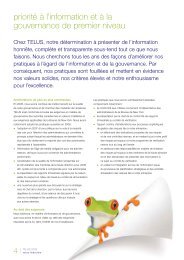
![DISK004:[98CLG6.98CLG3726]BA3726A.;28 - About TELUS](https://img.yumpu.com/16786670/1/190x245/disk00498clg698clg3726ba3726a28-about-telus.jpg?quality=85)
